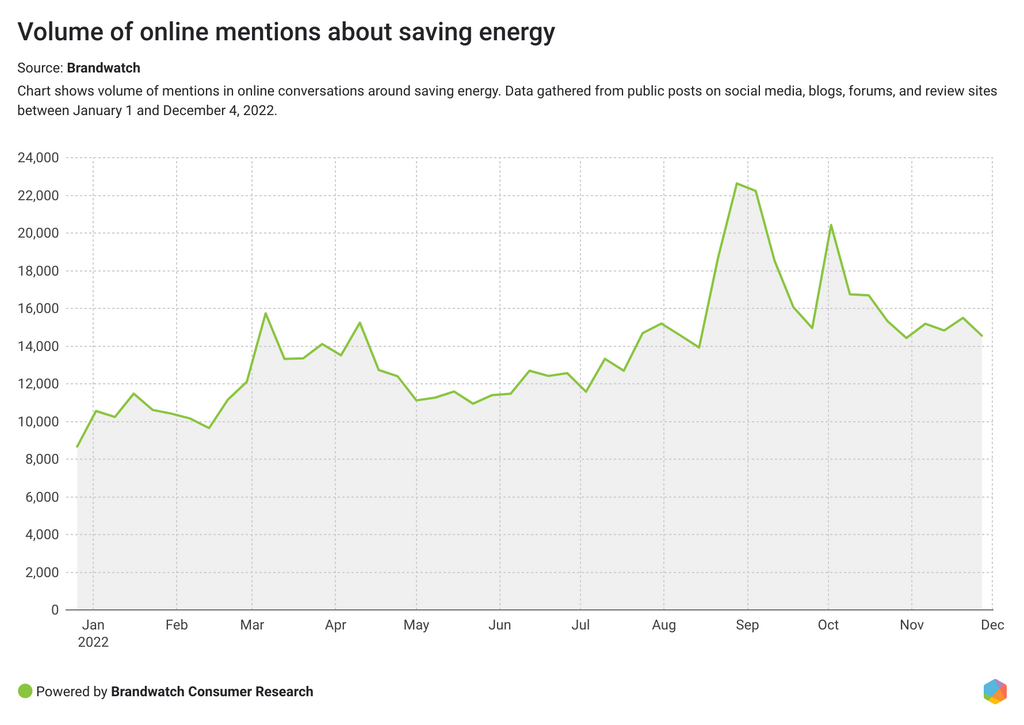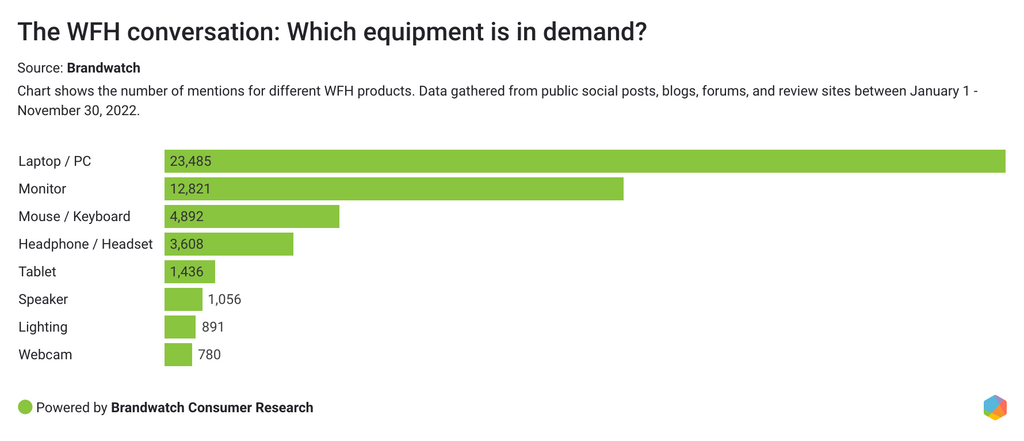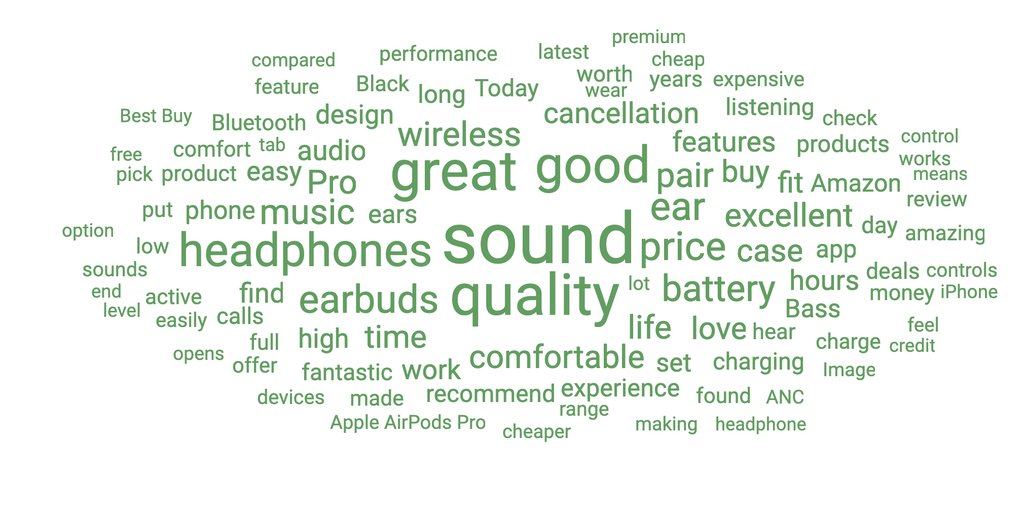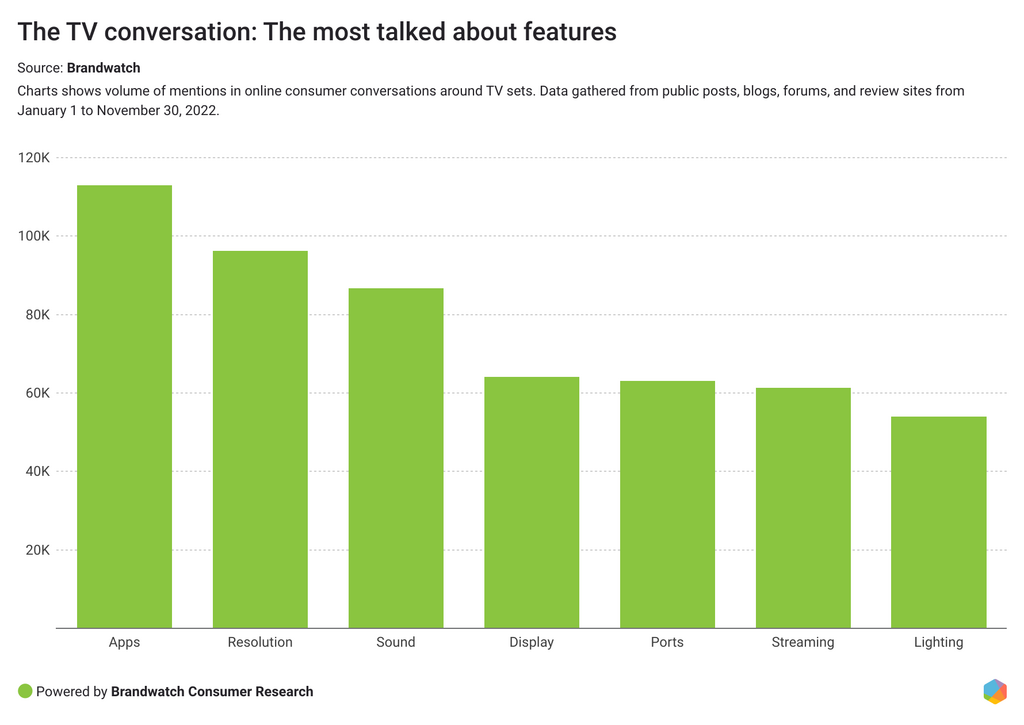Report
10 Consumer Tech Trends to Watch Out for Right Now
Discover the latest consumer tech trends
Book a meetingWe analyzed millions of data points to discover the latest trends in consumer tech to determine how consumer behavior is changing.
Technology is a crucial part of our everyday lives. We use technology for work, shopping, entertainment, education, or to improve our health. What shifts can we see in online consumer conversations right now?
In this report, we will cover:
- How people are turning to energy-efficient technology to save energy at home
- How repairs are trending as a way of making tech more sustainable
- The impact of inflation on smartphone purchase intentions
- How tech contributes to healthier lifestyles
- Accessibility in gaming: What are consumers’ pain points?
- WFH: What equipment is in demand?
- The popularity of noise-canceling headphones
- How consumers upgrade their at-home movie experience
- The emotional landscape around metaverses
- The most significant buying barriers for VR headsets
Trend #1: Saving energy becomes a higher priority for consumers
The rising cost of living and exploding energy prices make people search for ways to save money. Google search interest for “save energy” was at a five-year high in October 2022. And online discussions around saving energy or electricity were up 38% in 2022 compared to 2021.
Money, costs, and bills were the main talking points in those conversations online. Consumers often discuss how they want to buy devices that can help them save energy and, ultimately, money in the long run. At the top of the list were smart home technologies, kitchen or household appliances, and electrical devices like smartphones, laptops, or computers.
A look at the conversations relating to energy-saving and smart home technologies showed that people talked the most about devices to save on heating, like smart thermostats. Others talked about smart tech to save water or smart lighting to reduce electricity consumption
In the kitchen and household appliances conversations, people mainly discuss washing machines' energy consumption and energy-efficient cooking methods. In general, the topic of saving energy led to heated discussions over the past months in the media and online. Overall, the sentiment in related online discussions was negative, but some consumers still had a sense of humor about it:
Trend #2: Making tech sustainable: Can we fix it?
Though it’s clear that the rising cost of living and inflation has made consumers more price-sensitive, sustainability was still a relevant topic. Online conversations around consumer tech and sustainability increased by 12% in 2022 compared to 2021. Consumers mostly mention products like smartphones, laptops, computers, gaming accessories, and kitchen appliances in those conversations.
One way for consumers to become more sustainable is to repair their devices instead of purchasing new ones. But it’s easier said than done. Over 80% of all sentiment-categorized mentions around repairing and tech were negative, with ‘time’ frequently mentioned in those discussions. People complain about how long it takes to get things repaired and spending weeks without their devices. Others discussed the warranty and what to do if the issue arises after the warranty period expires.
Repairing issues is a huge topic in TV set conversations. Overwhelmingly, 90% of all sentiment-categorized mentions around TV sets and repairs were negative. Time was also a big topic. From having issues shortly after purchase or when the warranty ends or waiting to get the repaired TV back, people were not happy about their experiences. They talk about TV sets and the headache of getting them repaired more negatively than any other consumer tech product.
When repairs are done right and in a timely manner, consumers like to give praise online and share their positive experiences, as this comment demonstrates:
Based on this, brands should focus on improving their customer service to enhance customer experience. Keeping customers happy is crucial for brand loyalty, something that’s become harder and harder to get over the last few years.
Another topic in sustainability conversations and consumer tech is recycling. Repurposing old devices or manufacturing new ones with recycled materials can positively impact on our environmental footprint. Mentions around recycling and consumer tech increased 31% in 2022 compared to the previous year.
The main reason for this increase in online discussions is Samsung’s sustainability campaign with the K-pop band BTS. The brand’s Tweet mentioning BTS was among the most retweeted in all consumer tech conversations online in 2022. This sustainability campaign promotes Samsung’s approach to repurposing discarded fishing nets for new devices.
When looking at the sentiment in conversations relating to Samsung and BTS, 93% of all sentiment-categorized mentions were positive. Usually, when the the K-pop band is mentioned on social, the BTS ARMY is there to support it. And the purple heart emoji 💜 is what BTS fans often use to show their love for the band.
Trend #3: Price plays a bigger role in smartphone purchase conversations in 2022
Smartphones are probably the most important electronic devices in our everyday lives. We stay in touch with friends and family, listen to music, watch movies, take pictures, make purchases online, and manage our finances.
Which smartphone features are important to consumers today?
Price is the most talked about topic among consumers discussing buying smartphones, followed by battery life and camera features. In fact, price mentions increased nearly 120% in 2022 compared to 2021. In negative conversations relating to price, consumers complain about how expensive phones are.
Interestingly, the price was not the most negatively discussed topic in those conversations. Battery life and storage were the two mobile features with the highest percentages of negative discussions. This negativity is the reason why people express the desire to buy a new phone. Consumers talk negatively about their old phones having issues with battery and limited storage.
The design was the most positively discussed feature, with 46% of all sentiment-categorized mentions being positive.
Foldable phones? Consumers are not sold
For years, the design of phones has stayed pretty similar: rectangles in a flat shape. But before smartphones and social media, the flip phone was the coolest phone on the market.There was something really satisfying about snapping the phone closed after finishing a call. There’s even an article that talks about nostalgia and flip phones.
In the last couple of years, we saw smartphone brands introduce the idea of a foldable smartphone. How do consumers feel about it? Are foldable smartphones the next big thing?
There was definitely more chatter about foldable phones in 2022. Online consumer conversations increased by 9% compared to 2021, with 10% more unique consumers authoring discussions on this topic.
What do people love about foldable phones? The most mentioned word in positive discussions was "love", and a big screen was the most praised feature.

While there was more buzz and people were expressing their preference towards a larger screen, the percentage of negative discussions was higher than the positive ones. 61% of all sentiment-categorized mentions were negative.
What drove negative sentiment in consumer conversations? Consumers say foldable phones are too expensive and don’t see the benefit of buying one over a non-foldable phone. Consumers complain about a shorter battery life, apps not adjusting to the bigger, unfolded screen, and the phone being too chunky.
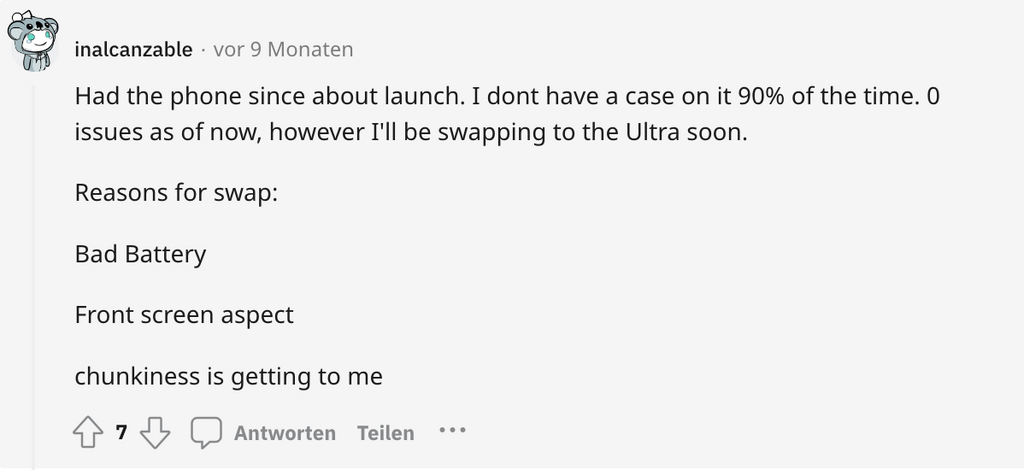
Overall, people showed more interest in foldable phones in 2022. For the second time, foldable smartphones are novelty items with more models coming on the market and technology still improving. We expect more chatter about the topic in 2023.
Trend #4: Using tech to boost healthy habits
Wearable tech can help consumers achieve their fitness goals and live healthier lifestyles. Fitness trackers and smartwatches have been on the market for years. But what’s trending in 2023? Let’s have a look.
While discussions around fitness tech stayed pretty constant throughout 2021 and 2022, the conversation relating to health gadgets increased by 10%. And according to Google Trends, the search interest for “health device” reached a five-year high in April 2022.
Smartwatches, like the Apple Watch and Garmin, were the most mentioned devices in consumer tech and health conversations. Many people discuss features helping track the heart rate, oxygen blood levels, or the quality of sleep.
We also looked at how consumers emoted in those discussions and discovered some interesting changes. In terms of sentiment, negative emotions have increased since 2021. Mentions expressing anger, fear, or sadness increased by nine, six, and four percent, respectively, between January 1 - November 30, 2022 and compared to the same period the year before.
“Anxiety” is one of the most frequently used words in those negative conversations. People mention getting anxious if they don’t use their smartwatches for some time. Others talk about how tracking their heart rate helps them stay aware of their anxiety and then be able to take action like meditate.
Fitness video games gained popularity in 2020, as many people stayed at home during lockdowns and couldn’t visit the gym. While finding ways to work out at home, some consumers turned to gaming, leading to popular fitness games being out of stock. Since then, the hype has slowed down. Online conversations around fitness games were 28% lower in 2021 than in 2020, and the volume of mentions in 2022 remained on the same level as in 2021.
With gyms being open again, what made people stick to their fitness games in 2022?
Gamification can make working out more accessible for people who have trouble visiting the gym regularly. We looked at how people expressed their emotions in conversations relating to fitness and gaming, and joy was the most expressed emotion, with 40% of all emotion-categorized mentions being joyful.
Consumers often used the words “amazing” and “great” in those conversations and say they love working out and are having fun. A VR rhythm game, Beat Saber, was among the most positively discussed games.
With more and more innovations in the VR market, we’ll probably see more fitness games in 2023 and beyond.
Trend #5: A diverse gaming community demands more accessibility
The gaming industry is huge. According to NewZoo, the gaming industry was expected to surpass $200 billion in revenue in 2022 and reach over 3 billion players.
The player demographics are getting more diverse. In 2020, more people aged 55 to 64 were playing video games. 32% more people in that age group played video games compared to 2018. Spending more time at home during the pandemic and looking for new ways to get entertained was one reason for this significant increase. Another reason why the older gaming group has grown in size in the last couple of years is that first-generation gamers are simply getting older.
With a more diverse audience playing video games, there’s a growing need to make games more inclusive. More and more gaming studios are implementing accessibility features in their games to make them playable for more people. Accessibility features may include features specific to impaired people, an easier difficulty mode, or more options to change the audio or displayed text.
This growing need for more accessibility is reflected in online discussions. Online conversations around gaming and accessibility increased by 14% in 2022 compared to 2021. And compared to 2019, it’s an even bigger increase: 52%. According to BuzzSumo, the most engaged with article about accessibility in gaming was a PlayStation article talking about the accessibility features of their new God of War game. And it received nearly 12k engagements.
While some consumers praised gaming brands for doing it right, there’s still room for improvement. 66% of all sentiment-categorized online mentions were negative, and anger was the most prominent emotion in those conversations. The lack of accessibility features was not the only cause of angry discussions. The gaming community also discussed what accessibility in gaming really means. Some players argue that adding story difficulty settings makes the games too easy, while others add several other reasons why accessibility features are important.
This presents a chance for brands in the gaming industry to educate their community and raise awareness about different accessibility options. Brands that listen to consumers and their needs can improve their product experience and ultimately reach new target audiences.
Trend #6: WFH equipment discussions are not slowing down
2020 and 2021 disrupted the working life of many. The pandemic and lockdowns forced people around the world to work from home, increasing the demand for WFH equipment. Employees equipped themselves to improve their home working environments with everything from keyboards to webcams to desk lamps.
What did the online conversation around WFH equipment look like in 2022? Is the demand declining with more people being back in the office? It doesn’t seem like it. Online conversations mentioning WFH equipment in 2022 remained pretty much on the same level as in 2021, with a slight decrease of 2%.
Laptops, monitors, mice, and keyboards were discussed the most in conversations about remote work and WFH equipment.
We looked at the audience demographics and it turns out that “family and parenting” and “technology” were among the most common interests of consumers discussing the topic on Twitter. Working parents benefit from working remotely and like to share their experiences online. People also discussed the WFH reimbursement programs their employers offer, and some stated that they switched jobs for companies with more attractive, flexible working policies.
With employees demanding more flexibility, WFH equipment is here to stay, and companies might benefit from adapting their policies to stay competitive.
Trend #7: The growing need for silence
The popularity of noise-canceling headphones has been growing since the technology became commercially available in 2000. Since then, companies have been competing to make the next best innovation in active noise-cancellation (ANC). The conversation about noise canceling increased by 20% in 2022 compared to the previous period. What is driving these discussions?
Noise-canceling means being able to mute the world around you, and the need for silence seems higher during the work week. On average, noise-canceling saw the fewest online mentions on Sundays and the highest on Wednesdays.
We also see that consumers with “artist” in their Twitter bio are more likely to talk about noise-canceling headphones than people in other professions. Almost one-third of mentions from Twitter users with a profession listed in the bio came from artists. And this profession seems to have the highest need for quiet surroundings.
According to our sentiment analysis, consumers positively discussed their headphones' sound quality, comfort, and battery life.
But not all conversations were positive. Negative mentions in 2022 increased by 27% compared to the previous period. And the biggest issue, as seen online, was related to other people rather than the technology. “People” and “loud” were the most used words in negative conversations. Headphone users discussed the need to shut out the noise from others at home, in the office, and when commuting or traveling. There seems to be demand for making the world quieter.
One of the most popular tweets in the analyzed conversations addresses how ANC is a blessing for neurodivergent people, but not everyone can afford the technology:
It turns out, parents of young children are also interested in noise-canceling headphones. This group of consumers discussed noise-canceling headphones as a way of protecting their kids at ear-splitting events like festivals.
Trend #8: Consumers upgrade their at-home movie experience
During the pandemic, TV sales grew by 12% globally.
Now, lockdowns are over, but people upgrading their TV sets is still trending online including adding background LED lighting or surround sound systems to make watching movies and shows more exciting.
This Tweet about background lighting was one of the most popular posts in consumer tech and TV conversations:
Which aspects of TV sets do people talk about the most? We broke down the online consumer conversation into different categories to see which features got the most mentions.
Apps gathered the most mentions in TV conversations, followed by screen resolution and sound. Features like sound, quality, easy setup, and usage received positive mentions. Negative topics included problems with apps and streaming, streaming services not working on phones, and issues getting support from customer service teams.
How are people feeling about ad-supported streaming services?
Advertising is a valuable revenue stream for platforms, be it social media or streaming platforms. Recently, more video streaming providers added ad-supported plans, usually at a lower monthly fee. Commercials are played before or during streaming. And it’s a little bit like in the old cable-TV days.
What do consumers think about these offerings? In times of high inflation, cheaper offerings could be an attractive option. In fact, “free” was the most mentioned word in positive online conversations. When consumers love the service and get access at a fair price, they praise the platform despite the added commercials. But these mentions are in the minority. Only 17% of all sentiment-categorized mentions around ad-supported streaming services were positive. Overwhelmingly, 83% were negative. Consumers often mention that commercials are annoying and that they are thinking about canceling their subscriptions.
People annoyed by commercials on streaming platforms specifically pointed out that they have to watch the same few commercials repeatedly, or the volume of the ads is way louder than the show they are watching.
Streaming providers with ad-supported plans can improve their customers' experience by adjusting the volume of the commercials. With more streaming providers adding these plans and marketers looking for additional channels to advertise, we’ll likely see a higher variety of commercials. Having to watch the same commercial over and over again will hopefully become a thing of the past in 2023.
Trend #9: Metaverses are coming, and there are a lot of mixed feelings
Metaverses are one of the biggest trending topics in tech. 2022 was a year with a lot of developments in the field, so it’s no wonder there was a lot of chatter online. Over 270k people talked about metaverses and consumer tech on Twitter in 2022. That’s an increase of 220% compared to 2021.
How do people feel about metaverses? When we looked at the online conversation, people seemed divided. 54% of all sentiment-categorized online mentions were negative, compared to 46% of positive mentions.
A look at emotion-categorized data shows what drove the positive and negative sentiments. The most expressed emotion in conversations relating to metaverses was joy, with 40% of emotion-categorized mentions being joyful. Anger was the second-most expressed emotion, with 35% of mentions categorized as such.
In joyful conversations, consumers highlighted how much fun they had engaging in metaverses. From their gaming experiences to interactions with others to digital products they can buy, there's a lot of joy in consumer conversations.
Angry discussions included consumers mentioning their disappointment with the graphics and performance of games. And some gamers also questioned the value of metaverses in general.
The metaverses are still in their early stages, and companies operating in this space will have to educate and persuade people to raise acceptance. More and more companies across different sectors are starting to experiment with how to promote their products in the digital space and connect with consumers. Mental health companies, for example, are experimenting with how they can offer their services in metaverses. In 2023 we’ll see more innovative ideas in the digital space.
Trend #10: Motion sickness keeps consumers from buying VR headsets
VR headsets were once futuristic concepts but are now very much a reality. Today, they are a valuable technology for different sectors like healthcare, manufacturing, and education. For consumers, gaming is the most popular use case. According to Statista, the VR hardware and software market will increase by nearly 11% from $4.6 billion in 2022 to $5.1 billion in 2023. New hardware and software led to a lot of online discussions in 2022, with an increase of 17% compared to the year before.
A look at BuzzSumo data shows that over 7,800 published articles about VR headsets generated over 746k engagements. The article with the highest engagement was a Business Insider interview with PlayStation founder Ken Kutaragi saying that “VR headsets are annoying.” Oculus founder Palmer Luckey placed second with an article introducing his VR headset idea that if you die in-game you die in real. For obvious reasons, he didn’t try it on. This controversial idea was also discussed online and caused the second-highest spike in online conversations about VR headsets in 2022.
Controversies aside, how are consumers talking about VR headsets online? Which features are they excited about? And what are their buying barriers?
When discussing VR headsets, consumers often mention characteristics like price, experience, and screen quality. Games were frequently mentioned in conversations relating to experiences. It was also the topic with the highest percentage of joyful conversations, with 32% of all emotion-categorized mentions being joyful. Consumers described their gaming experience with words like “good,” “great,” “fun,” “love,” or “enjoy.”
Interestingly, the price was only the second-most negatively talked about topic in VR conversations. The discussions with the highest percentage of negative sentiment was about motion sickness, with 83% of all sentiment-categorized mentions being negative. The general VR conversation showed that 67% of all sentiment-categorized mentions were negative. In those conversations, consumers complained about feeling sick after using VR headsets for a while or not being able to use VR headsets at all.
Motion sickness is not a new issue when it comes to new technologies. People experience it watching 3D movies or playing certain video games. And for some consumers, motion sickness is a big reason they won’t buy a VR headset in the near future. Besides high prices, making VR headsets as comfortable as possible is one of the biggest challenges for companies in this space. Although some gamers say that the body does get used to it after a while.
Final thoughts
Influenced by the aftermath of the pandemic and economic challenges, consumer buying behavior is shifting. Consumers are more careful with spending their money and are searching for ways that tech can help them save money in the long run. Nevertheless, they still expect brands to be sustainable and inclusive in all aspects of product development from smartphones or gaming products. Companies need to stay up-to-date on how consumer needs are shifting to curb the competition.
